|
|
|
| Published
on 8
Sep
2013 |
All rights reserved.
|
|
|
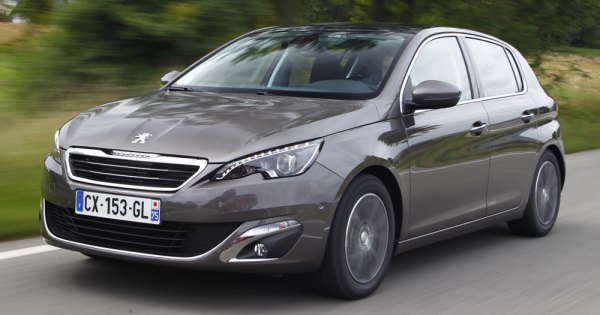
|
Since 306 was introduced in
the early 1990s, Peugeot 30X series has been a strong player in the
global C-segment. We love the 306's looks, packaging and driving
dynamics very much, but the next 307 was the most commercially
successful, having sold 3.8 million copies worldwide as of today
(incredibly, it is still being sold in some developing countries). Its
continuous presence actually hurts the following 308, which recorded
only 1.25 million units of sales from its launch in 2007 until the end
of 2012. The number may continue to grow in the next few years, but it
will be hopeless to reach the 2 million mark, let alone the record of
its predecessor. That is not much of a surprise as the 308 fails to
excel in the increasingly competitive segment.
The successor of 308 should be 309, but wait, wasn't that name already
used by the predecessor of 306 in the 1980s? You might remember that
the original 309 did not follow the logical step of nomenclature
because it was not an in-house project but taken from the defunct
Talbot division. Now Peugeot finally runs out of numbers. As it wants
to keep the signature nomenclature with a zero in the middle, it
decides to freeze the name from now on, just like other car makers. To
me it is a sad decision, as I always prefer to distinguish different
generations of cars from their names. To the marketers of PSA, however,
this might save their effort to register new trademarks on each market.
Moreover, 308 is a lucky number in Chinese, pronouncing like "lively"
and "fortune". It should be beneficial to the sales in this important
market.
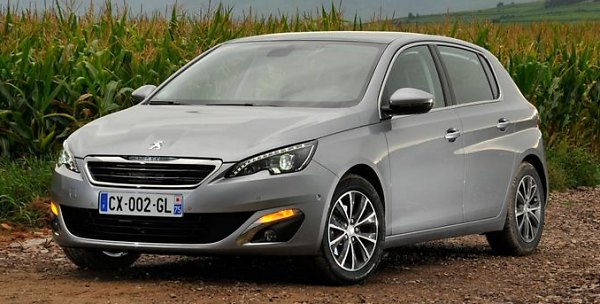
|
A first glance to the second generation 308 will find it to
be very conservative. It looks a lot boxier than the old 308. There are
very few curves in its exterior, although all edges and corners are
smoothened. The irregular-shaped headlights (with LED daytime running
lights incorporated like many cars these days) and C-shape taillights
attempt to inject a bit spice, but just a little bit is not sufficient
to change your general perception. The upper front grille is quite
boring, failing to raise your interest. Turn to the sides, it has the
same self-restraint as a Volkswagen Golf. Yes, this is the French Golf.
It sacrifices the traditional core values (innovations and strong
taste) of French cars in a bid to win more average buyers. To me that
is not something to cheer about.
The exterior dimensions are not remarkably different from the old car.
It is just a tiny bit shorter and narrower, but the margin is too small
to mention. More noticeable is the height, which is dropped by 40 mm.
Admittedly, the old car was too tall at nearly 1500 mm. Now the new car
is close to the class norm. The 2620 mm wheelbase is just 12 mm longer
than before, so don't expect the new car to offer class-leading space.
Much better is the boot, which can swallow 435 liters, plus another 35
liters beneath the boot floor.
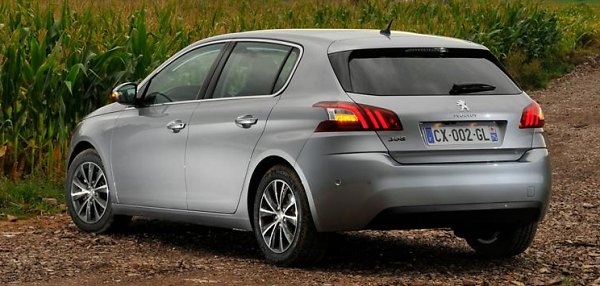 |
However, the most remarkable thing about the new car is not
more but less – built on the new EMP2 platform that has been first seen
on Citroen C4 Picasso, it is said to be 140 kg lighter than its
predecessor. Weight saving comes mainly from the use of more
high-strength steel, aluminum parts (bonnet, front fenders and some
suspension components) and plastic composites (tailgate and boot
floor). As a result, a range-topping 1.6 THP model tips the scale at
only 1165 kg. According to my figures, it actually undercuts its direct
predecessor with the same engine by 162 kg. It is even lighter than the
new Golf VII, which is already renowned for lightweight MQB platform.
Going from the heaviest to the lightest in the class, Peugeot has done
a great job.
I suspect the interior also plays a role in the weight saving. This is
the most minimalist cabin in the family car class. Its center console
is free of buttons and switches as 90 percent of functions have been
put onto the 9.7-inch touchscreen. The design theme is built on the
strength of 208, just finished in high-quality plastics and trims,
although you can still pick holes when compared with the impeccable
Golf or Audi A3. As in 208, the instrument pod is positioned above the
small-diameter steering wheel so that you see them above rather than
through the wheel. Thanks to a better driving position, the wheel rim
doesn't block the view to instrument as much as the smaller Peugeot.
Overall, this cabin looks stylish and pretty upmarket. On the downside,
the rear seats remain cramped, offering limited legroom (and headroom
as well if the panoramic glass roof is opted). Six-footers will find
them unbearable. It should have spent more space to rear passengers
than luggage.

|
Peugeot's powertrain range is rather narrow. It relies
heavily on the BMW-engineered 1.6 THP direct-injection petrol turbo and
its own 1.6 e-HDi turbo diesel. Both engines are available with 2
states of tune (125 hp or 156 hp for 1.6 THP and 92 hp or 115 hp for
1.6 e-HDi). Thanks to the low kerb weight, the higher power petrol is
good for 0-60 mph in sub-8 seconds, more than good enough for any
family car buyers. The diesel is slower, but its superior low-down
torque is punchy enough for everyday use. In contrast, the entry-level
1.2-liter three-cylinder engine is obviously underpowered at 82 hp.
Fortunately, its turbocharged version is arriving next year, ditto a
super-frugal 1.6 BlueHDi.
Disappointingly, the driving dynamics has taken a backward step from
its predecessor. In order to steal sales from Golf, Peugeot opted for a
soft setup on its MacPherson-struts and torsion-beam suspensions. This
does deliver a supple ride that French cars are traditionally renowned
for, but the flipside is a lot of initial body roll before it settles
in corners. This hurts driving confidence and makes the 308 Mk2 far
less enthusiastic to steer than its key rivals. Moreover, the
electrical power steering on this car is too light and numb. It fails
to weigh up progressively in corner, thus you have no idea how much
grip is left at the front tires. For those who still remember 306, the
new car is definitely disappointing.
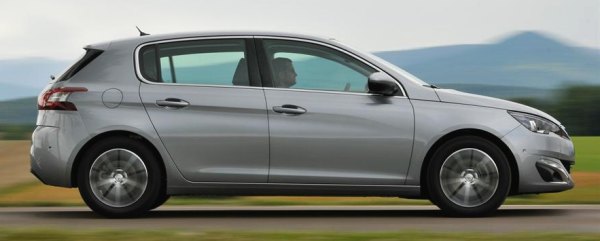
|
The downgraded handling could have been forgivable if the
car provided class-leading refinement, but it doesn't. Although this is
generally a refined car, it can't quite match the new Golf, especially
on highway, where the wind noise generated around the mirrors is
excessive.
Overall, the new 308 leaves quite a lot to be desired – it looks
boring; Its rear seat is cramped; Its engine range is not as versatile
as rivals (especially the cheaper engines); and its handling is
unexciting. The old Peugeot magic has gone.
|
Verdict:    |
Published
on 18
Jan 2015
|
All rights reserved.
|
|
308 GT
|
|
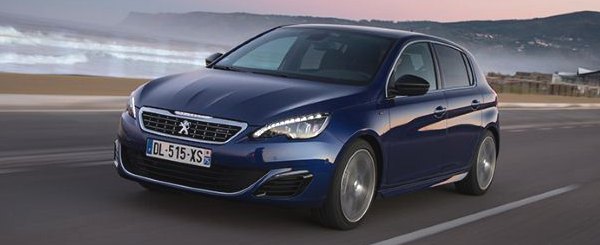
|
There is a huge difference
between GTi and GT. When Volkswagen introduced Golf GTi in 1976, the
“i” meant “injection” engine. Somehow, it was not exactly a GT with a
more powerful engine. Traditionally, the term GT meant a large and
luxurious 2-door coupe which had a powerful engine and worked best as a
cross-continental high-speed cruiser. In contrast, Volkswagen defined
the GTi as a B-road hot hatch which emphasized on responsive handling
and practicality. Having understood these terms, you can see what a
Peugeot 308 GT is. While its offers more performance than lesser 308s,
it still biases towards comfort and refinement. You may call it a warm
hatch.
The second generation 308 GT is powered by the familiar 1.6 THP direct
injection twin-scroll turbo engine with Valvetronic and twin-variable
camshaft phasing. Producing 205 hp and 210 lbft, it is not as powerful
as real hot hatches like Golf GTi (220 or 230 hp), Ford Focus ST (250
hp), Renault Megane RS (275 hp) and Seat Leon Cupra (265 or 280 hp).
Peugeot has a 270 hp version of the engine, but it is reserved for the
forthcoming 308 R, which should take on the hot hatches. As a warm
hatch, however, the 308 GT is more powerful than Seat Leon FR and Kia
Pro Ceed GT. It is good for 146 mph, though I would expect better
acceleration than its 0-60 mph time of 7.1 seconds suggested,
considering the car is remarkably lightweight at 1200 kg. On the road,
the car feels brisk rather than swift. The small engine has more turbo
lag than the larger engine of Golf GTi, too. Engine noise is subdued if
not the artificial sound generated by speakers. The short-throw 6-speed
manual gearbox is a joy to play though.
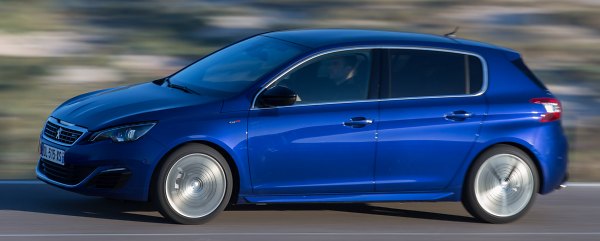 |
As in the cases of Ford Focus ST, Seat Leon FR or VW Golf GTD, you can
opt for diesel power on the Peugeot. This version of 2.0 HDi motor
produces 180 hp and 295 lbft of torque and works exclusively with an
Aisin 6-speed automatic (the manual could not withstand the torque).
With so much torque, it rarely feels slower than the petrol, but if you
are hurry in corners you will find lots of understeer and torque steer
to fight against. The extra 120 kg of weight at the nose also hampers
its turn-in response and balance. It’s not as well engineered as its
rivals.
Therefore it is better to turn our attention back to the petrol
version. Its chassis is mildly tuned to deliver slightly better
handling than the regular car. The suspension is set 10-20 percent
stiffer. Ride height is lowered by 7 mm up front and 10 mm at the rear.
Hydraulic bump-stops have been added to the shock towers to reduce
noise. It also gets larger brakes and lower profile tires on 18-inch
wheels. As you would expect, it is still far from a sharp driver’s car.
Body control and steering response are half-way between a regular hatch
and hot hatch, while ride quality and noise suppression are good. More
disappointing, the steering remains as lifeless as the regular car’s,
failing to weight up in corners. Switch to sport mode adds only more
weight and more artificial self-centering without actually giving more
feedback. This means the car has not much fun to drive. It is only a
faster version of the 308. Some people might be attracted by the 308's
quality cabin or understated looks, but that is not a reason to choose
the go-faster version. Seat Leon FR is clearly a better warm hatch.
|
Verdict:    |
Published
on 24
Sep 2015
|
All rights reserved.
|
|
308 GTi
|
|
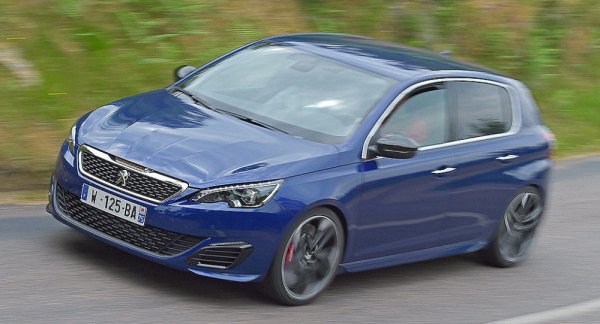
|
The last time Peugeot built
a C-segment hot hatch was the mighty 306 GTi. That was nearly 20 years
ago! Things changed a lot during this period. Today the segment is no
longer one-dimensional. On the one hand there are hardcore driver’s
cars like Renault Megane RS275 or Honda Civic Type R, on the other hand
there are everyday hot hatches like Volkswagen Golf GTi or Ford Focus
ST. At the top
there are also some very powerful and expensive models like Mercedes
A45 or Audi RS3. The market is so diverse that no one can claim to be
the King of hot hatches like the days of 306 GTi. So where is the new
308 GTi in the spectrum? It is pretty close to Golf GTi. In other
words, it aims to be a high-quality and practical all-rounder instead
of an all-out fast car.
The 308 GTi looks probably too civilized for a hot hatch. Apart from
mesh grilles and larger wheels there’s nothing distinguish it from the
regular 308, which is already a dull design. There is no striking
spoilers or diffusers, whereas the twin-exhaust is understated. The
interior is better, as the dashboard design is striking and the GTi’s
exclusive bucket seats add some visual appeal. Build quality is high
for a French car, or just a tad below the level of Volkswagen.
The French car also mirrors its Volkswagen rival by offering two levels
of performance. The base car provides 250 horsepower to enable 0-60 mph
in 5.9 seconds, while the hotter model is good for 270 hp and 0-60 mph
in 5.7 seconds. Both have a top speed regulated at 155 mph. Powering
them is yet another version of the long-lived 1.6 THP engine, which is
remarkably small for the power they produce. The high-power version is
practically the same motor as that of RCZ R coupe, although it is
modified to comply with EU6 emission and added with automatic
stop-start to save fuel. Both versions generate the same 243 lbft of
torque which is also the limit of the RCZ R-sourced 6-speed manual
gearbox.

|
As the 308 is unusually light at just 1200 kg – thanks to that small
motor as well as the lightweight EMP2 platform – the 270 hp model is
pretty fast on the road, certainly feels faster than Golf GTi
Performance and close to the level of Seat Leon Cupra 280. The small
motor is respectably responsive and punchy, with plenty of torque to
avoid rushing the slightly ponderous gearshift. Meanwhile, its fuel
economy and rated emission are remarkable. It satisfies the best of
both worlds. The only weakness is the lack of a sporty soundtrack, as
the exhaust note is deliberately suppressed to maintain refinement.
The chassis is predictably beefed up. Developed by Peugeot Sport, the
308 GTi has its suspensions lowered by 11 mm and all bushings
stiffened. The front springs and rear torsion beam get 60 percent and
100 percent stiffer, respectively. The anti-roll bars, power steering
and traction control are retuned. In addition, the 270 hp model gets
larger (19-inch) wheels, larger front brakes (380 mm instead of 330
mm), grippier Michelin Super Sport rubbers and a standard Torsen LSD.
As a result, its handling is transformed. Its new-found front-end grip
enables a responsive turn-in and strong mid-corner bite. It can carry
big speed into corner. Unlike a Megane RS, its handling is more about
grip and less about throttle adjustability, but that doesn't prevent it
from being an effective A-to-B machine. The ride is always slightly on
the firm side, which is the result of lacking adaptive dampers, but it
returns a taut body control and good high-speed composure. The tiny
steering wheel gives an impression of sportiness, but it is actually
light and short of feel. That, in addition to the secure rear end and
dull exhaust note, means the 308 GTi is not very engaging to drive.
What it lacks is not outright speed but driver interaction. In this
respect, the slower Golf GTi Performance is actually better.
|
Verdict:    |
|
|
|
|
|
|
|
|
|
|
308 1.6 HDi
|
2013
|
| Front-engined,
FWD |
| Steel monocoque |
Steel, aluminum, composites
|
| 4253 / 1804 / 1457 mm |
| 2620 mm |
Inline-4 diesel
|
| 1560 cc |
SOHC 8 valves
|
VTG turbo
|
| CDI |
| 115 hp |
199 lbft
|
| 6-speed manual |
F: strut
R: torsion-beam
|
| - |
| 205/55R16 |
1160 kg
|
| 122 mph (c) |
9.6 (c)
|
| - |
|
308 1.6 THP
|
2013
|
| Front-engined,
FWD |
| Steel monocoque |
| Steel, aluminum, composites |
| 4253 / 1804 / 1457 mm |
| 2620 mm |
Inline-4
|
| 1598 cc |
DOHC 16 valves, VVT
|
Turbo
|
| DI |
| 156 hp |
177 lbft
|
| 6-speed manual |
F: strut
R: torsion-beam
|
| - |
| 225/45R17 |
1165 kg
|
| 134 mph (c) |
7.6 (c)
|
| - |
|
308 1.2 THP
|
2014
|
| Front-engined,
FWD |
| Steel monocoque |
| Steel, aluminum, composites |
| 4253 / 1804 / 1457 mm |
| 2620 mm |
Inline-3
|
| 1199 cc |
DOHC 12 valves, DVVT
|
Turbo
|
| DI |
| 130 hp |
170 lbft
|
6-speed automatic
|
F: strut
R: torsion-beam
|
| - |
| 225/45R17 |
1150 kg
|
| 124 mph (c) |
9.2 (c)
|
| - |
|
|
|
|
|
Performance
tested by: -
|
|
|
|
|
|
|
308 GT
|
2015
|
| Front-engined,
FWD |
| Steel monocoque |
| Steel, aluminum, composites |
| 4253 / 1804 / 1447 mm |
| 2620 mm |
Inline-4
|
| 1598 cc |
DOHC 16 valves, DVVT, VVL
|
Turbo
|
| DI |
205 hp / 6000 rpm
|
210 lbft / 1750-4500 rpm
|
| 6-speed manual |
F: strut
R: torsion-beam
|
| - |
| 225/40WR18 |
1200 kg
|
| 146 mph (c) |
7.1 (c)
|
| - |
|
308 GTi 270
|
2015
|
| Front-engined,
FWD |
| Steel monocoque |
| Steel, aluminum, composites |
| 4253 / 1804 / 1446 mm |
| 2620 mm |
Inline-4
|
| 1598 cc |
DOHC 16 valves, DVVT, VVL
|
Turbo
|
| DI |
270 hp / 6000 rpm
|
243 lbft / 1900-5000 rpm
|
| 6-speed manual |
F: strut
R: torsion-beam
|
| - |
| 235/35WR19 |
1200 kg
|
| 155 mph (limited) |
5.7 (c)
|
| - |
|
|
|
|
|
|
| Performance
tested by: - |
|
|
|
|
|
|
|
|
Copyright©
1997-2015
by Mark Wan @ AutoZine
|
|